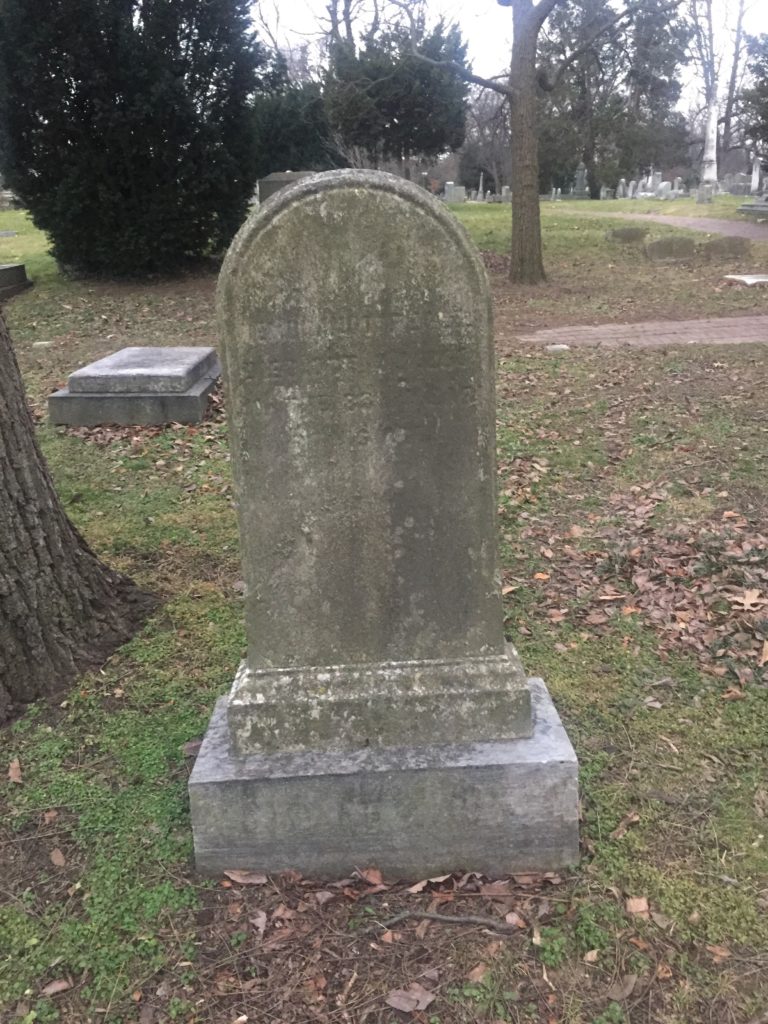Erik Visits an American Grave, Part 1,021
This is the grave of Rembrandt Peale.

Born in 1778 in Bucks County, Pennsylvania, Peale was the son of the famed early American painter Charles Wilson Peale. Old Man Peale had every intention of his son becoming an artist, so he named him after Rembrandt. No pressure or anything. Thanks to the son’s training, inherent talent, and connections, he rose quickly as his father’s son. His father introduced him to George Washington when he was painting the president’s portrait in 1787. By 1795, still only 17 years old, Rembrandt Peale painted his own portrait of Washington as an old man, which was well-received. As part of the family business, Peale and his brothers were tasked with painting copies of the old man’s pictures and traveling across the nation showing them. This made sense of course, as travel was slow and brutal and the idea of traveling exhibitions of original paintings was not feasible in the late 18th century.
Having lots of money thanks to his father, Peale was able to travel frequently around Europe, studying the Old Masters and generally living the high life. He studied in London under the famous expatriate American artist Benjamin West. He became relatively successful during his multiple trips to Paris and became known for his portraits, which was absolutely the best way to make money as an artist during these years when rich people really wanted to have multiple portraits painted. In fact, he was offered the position of court painter for Napoleon, but evidently turned that down. Kind of too bad, would have been interesting for an American artist to hold that post.
Peale studied the great paintings at The Louvre and other museums there and so decided to commit himself primarily to history paintings. Peale really wasn’t as successful at this stage in his life in the U.S. as he was in Europe. Being no small snob, he was pretty open that Americans were yokels and his classical-styled painting were intended to uplift the dummies. This wasn’t really appreciated. For example, his 1811 painting, The Roman Daughter, showed a daughter protecting her father in war in part by feeding him from her breast. This was seen as too weird by Philadelphians, which of course Peale had great contempt for. Today, the city’s residents probably would have thrown batteries or rocks at him. City of Brotherly Love indeed.
But Peale was less known in Baltimore than in Philadelphia. So in 1814, he started his own museum there for public art education that was most noted for using gaslight, making him one of the first people to use it in the U.S., though not before his brother Rubens had done the same thing for his own museum back home in Philly. He couldn’t keep it going because the guy was horrible with money but Rubens saved it for the family. During these years, mostly the second half of the 1810s, he stopped painting. Evidently, he was really touchy and could not take negative criticism so he just stopped. But of course he needed money when the museum didn’t work out. So what kept Peale going was his portraiture. He wasn’t strictly an adherent to portraits, but he was known and again, it was the way to make money. With his Washington portrait famous, getting your portrait painted by Peale also became a way to connect yourself with the long dead president. John C. Calhoun, DeWitt Clinton, William Henry Harrison, Albert Gallatin, Thomas Jefferson, and any number of other politicians paid Peale grandly for his work. As he aged, Peale also went back into the American Revolution to paint history pictures that would also sell to a public already turning the Founders into a fetish. Washington Before Yorktown, from 1823, is a classic example of this, a subject he already knew well that could be marketed for a public who wanted to see their nation’s founders venerated. Moreover, he would just paint the same Washington picture over and over and sell the copies for a lot of money. He painted at least 79 copies of his most famous Washington portrait, one of which was purchased for the U.S. Capitol building in 1832. He moved around a lot during these years trying to get commissions. In 1822, he left Baltimore for New York. He moved to Boston in 1826. Then finally he returned to Philadelphia in 1831, where he lived the rest of his life.
By the end of his life, Peale really was one of the last connections to Washington who still lived. This alone got him attention. So for example, when Matthew Brady become of the nation’s top photographers, one of the main people he wanted to memorialize before death was Peale, which he did. He also remarried after his first wife died, to one of his own students, Harriet Cany, who became a reasonably important painter herself.
Peale died in 1860, at the age of 82.
Rembrandt Peale is buried in Woodlands Cemetery, Philadelphia, Pennsylvania.
Let’s look at some of Peale’s work:




If you would like this series to visit other American portrait painters, you can donate to discover the required expenses here. John Singer Sargent is in Brookwood, Surrey, England and John Singleton Copley is in London and you should send me there. As for people actually buried in the United States, William Merritt Chase is in Brooklyn and Robert Brackman is in Mystic, Connecticut. Previous posts in this series are archived here.
